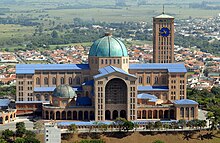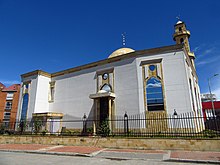Religion in South America
| Religion by country |
|---|
|
|
Religion in South America has been a major influence on art, culture, philosophy and law. Christianity is the main religion, with Roman Catholics having the most adherents. Sizeable minorities of non-religious people and adherents of other religions are also present.
Religious freedom[]
Currently, all countries in the region in general are separate of the Catholic Church and declared secular states, which guarantees freedom of religion for its inhabitants. However, in Peru, and the Dominican Republic Roman Catholicism serves as the official religion. In both countries Catholic religious education is mandatory, and in most nations Roman Catholicism still sways the population.
Christianity[]

According to Pew Research Center 83.43% of the South American population is Christian,[2] although less than half of them are devout.
Catholicism[]
In many South American countries Catholicism is the most professed Christian denomination. In Paraguay, Peru, Colombia and Argentina more than three-quarters of the population is Catholic. Catholicism was the only religion allowed in the colonial era; the indigenous were forced to abandon their beliefs, although many did not abandon it at all, for example, countries with predominantly Amerindian population such as Bolivia and Peru there is a syncretism between indigenous religions and the Catholic religion, that has occurred since colonial times. In Brazil or Colombia, Catholicism was mixed with certain African rituals.
Protestantism[]
Protestantism has been a presence since the nineteenth century, as a minority, but has had a strong increase since the 1980s. The majority of Latin American Protestants in general are Pentecostals.[3] Brazil today is the most Protestant country in South America with 22.2% of the population being Protestant,[4] 89% of Brazilians evangelicals are Pentecostals, in Chile represents 79% of the total evangelicals in that country, 69% in Argentina and 59% in Colombia.[3] On the other part, in Uruguay 66% of evangelicals are Methodists, while only 20% are Pentecostal.[3]
Spiritism[]
Brazil is the country with more practitioners in the world of Allan Kardec's codification of the Spiritism, followed by over 12 million people, with 30 to 45 million sympathizers. Most followers of the Spiritism are people that were mostly Catholic, Protestants and Atheists respectively.
Chico Xavier wrote over 490 books, which complements the spiritualist doctrine.
Eastern Orthodoxy[]
Eastern Orthodox Christianity was brought to South America by groups of immigrants from several different regions, mainly Eastern Europe and the Middle East. This traditional branch of Eastern Christianity has also spread beyond the boundaries of immigrant communities. There are several Eastern Orthodox ecclesiastical jurisdictions in South America, organized within the Assembly of Canonical Orthodox Bishops of Latin America.[5]
Oriental Orthodoxy[]
Several groups of Christian immigrants, mainly from the Middle East, Caucasus, Africa and India, brought Oriental Orthodoxy to the South America. This ancient branch of Eastern Christianity includes several ecclesiastical jurisdictions in the South America, like Coptic Orthodox Church in South America and Syriac Orthodox Church.[6]
Other Christians[]
Practitioners of The Church of Jesus Christ of Latter-day Saints and Jehovah's Witnesses religions also are exercised in Latin America.
Other religions[]

Argentina has the largest communities of both Jews[7][8][9] and Muslims[10][11][12] in Latin America.Practitioners of the Judaism, Buddhist, Islamic, Hinduism, Bahá'í Faith, and Shinto denominations and religions also exercised in Latin America.[13]
Hinduism is the second-largest religion in Suriname. According to the 2012 census of Suriname, Hindus constitute 22.3% of the population. Suriname has the second largest percentage of Hindus in the Western Hemisphere, after Guyana (24.8%).
Indigenous creeds and rituals are still practised in countries with large percentages of Amerindians, such as Bolivia and Peru.
Statistics[]
Country By Religion in South America (2020 estimate):
| Countries | Total Population | Christians % | Christians Population | Unaffiliated % | Unaffiliated Population | Other % | Other Population | Sources |
|---|---|---|---|---|---|---|---|---|
| 43,830,000 | 85.4% | 37,420,000 | 12.1% | 5,320,000 | 2.5% | 1,090,000 | [14] | |
| 11,830,000 | 94% | 11,120,000 | 4.1% | 480,000 | 1.9% | 230,000 | [15] | |
| 210,450,000 | 88.1% | 185,430,000 | 8.4% | 17,620,000 | 3.5% | 7,400,000 | [16] | |
| 18,540,000 | 88.3% | 16,380,000 | 9.7% | 1,800,000 | 2% | 360,000 | [17] | |
| 50,000,000 | 79.5% | 39,750,000 | 15.5% | 10,000,000 | 5% | 2,500,000 | [18] | |
| 16,480,000 | 94% | 15,490,000 | 5.6% | 920,000 | 0.4% | 70,000 | [19] | |
| 850,000 | 67.9% | 580,000 | 2% | 20,000 | 30.1% | 250,000 | [20] | |
| 7,630,000 | 96.9% | 7,390,000 | 1.1% | 90,000 | 2% | 150,000 | [21] | |
| 32,920,000 | 95.4% | 31,420,000 | 3.1% | 1,010,000 | 1.5% | 490,000 | [22] | |
| 580,000 | 52.3% | 300,000 | 6.2% | 40,000 | 41.5% | 240,000 | [23] | |
| 3,490,000 | 57% | 1,990,000 | 41.5% | 1,450,000 | 1.5% | 50,000 | [24] | |
| 33,010,000 | 89.5% | 29,540,000 | 9.7% | 3,220,000 | 0.8% | 250,000 | [25] | |
| South America | 422,194,269 | 83.43% | 385,210,000 | 9.18% | 35,480,000 | 7.39% | 11,080,000 |
See also[]
- Major religious groups
- Religion in Africa
- Religion in Asia
- Religion in Europe
- Religion in Oceania
- Religion in North America
References[]
- ^ "Basílica de Aparecida aguarda 160 mil pessoas". Archived from the original on 2012-02-23. Retrieved 2015-12-05.
- ^ "Religious Composition by Country, 2010-2050". Archived from the original on 2019-12-21. Retrieved 2020-10-18.
- ^ Jump up to: a b c «Luis Palau: Evangelist to Three Worlds», Christianity Today, 20 de mayo de 1983, pp. 30-1. Luis Palau, «The Gospel's Social Impact», Briefing (Portland, Oregon: Cruzada Luis Palau), verano de 1984, pp. 14-16.
- ^ "Censo Demográfico 2010". Archived from the original on 2020-11-24. Retrieved 2020-06-15.
- ^ "Organizations - Assembly of Canonical Orthodox Bishops of Latin America". oca.org. Archived from the original on 2018-03-05. Retrieved 2018-03-05.
- ^ "Meeting with the President of Brazil". 27 October 2016. Archived from the original on 11 March 2018. Retrieved 11 March 2018.
- ^ LeElef, Ner. "World Jewish Population". Archived from the original on 2020-05-17. Retrieved 2008-01-09.
- ^ "The Jewish People Policy Planning Institute; Annual Assessment, 2007". Archived from the original on 2017-11-07. Retrieved 2015-08-09.
- ^ United Jewish Communities; Global Jewish Populations Archived 2008-05-31 at the Wayback Machine
- ^ "Argentina". Archived from the original on 2019-06-04. Retrieved 2019-05-26.
- ^ "Argentina". Archived from the original on 2020-08-03. Retrieved 2019-05-26.
- ^ "Arabs and Muslims in Latin America". 17 March 2005. Archived from the original on 11 November 2020. Retrieved 9 August 2015 – via news.bbc.co.uk.
- ^ "Religion & Theology in Latin America - LANIC". lanic.utexas.edu. Archived from the original on 2009-11-05. Retrieved 2015-08-09.
- ^ "Religious Composition by Country, 2010-2050". www.pewforum.org. Archived from the original on 2019-12-21. Retrieved 2020-10-18.
- ^ "Religious Composition by Country, 2010-2050". www.pewforum.org. Archived from the original on 2019-12-21. Retrieved 2020-10-18.
- ^ "Religious Composition by Country, 2010-2050". www.pewforum.org. Archived from the original on 2019-12-21. Retrieved 2020-10-18.
- ^ "Religious Composition by Country, 2010-2050". www.pewforum.org. Archived from the original on 2019-12-21. Retrieved 2020-10-18.
- ^ "Religious Composition by Country, 2010-2050". www.pewforum.org. Archived from the original on 2019-12-21. Retrieved 2020-10-18.
- ^ "Religious Composition by Country, 2010-2050". www.pewforum.org. Archived from the original on 2019-12-21. Retrieved 2020-10-18.
- ^ "Religious Composition by Country, 2010-2050". www.pewforum.org. Archived from the original on 2019-12-21. Retrieved 2020-10-18.
- ^ "Religious Composition by Country, 2010-2050". www.pewforum.org. Archived from the original on 2019-12-21. Retrieved 2020-10-18.
- ^ "Religious Composition by Country, 2010-2050". www.pewforum.org. Archived from the original on 2019-12-21. Retrieved 2020-10-18.
- ^ "Religious Composition by Country, 2010-2050". www.pewforum.org. Archived from the original on 2019-12-21. Retrieved 2020-10-18.
- ^ "Religious Composition by Country, 2010-2050". www.pewforum.org. Archived from the original on 2019-12-21. Retrieved 2020-10-18.
- ^ "Religious Composition by Country, 2010-2050". www.pewforum.org. Archived from the original on 2019-12-21. Retrieved 2020-10-18.
- Religion in South America
